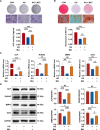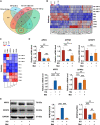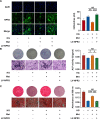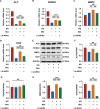Metformin combats high glucose-induced damage to the osteogenic differentiation of human periodontal ligament stem cells via inhibition of the NPR3-mediated MAPK pathway
- PMID: 35841070
- PMCID: PMC9284897
- DOI: 10.1186/s13287-022-02992-z
Metformin combats high glucose-induced damage to the osteogenic differentiation of human periodontal ligament stem cells via inhibition of the NPR3-mediated MAPK pathway
Abstract
Background: High glucose-induced damage to the osteogenic differentiation of human periodontal ligament stem cells (PDLSCs) has long been a challenge to periodontal regeneration for diabetic individuals. Metformin is an anti-hyperglycemic drug that exhibits abundant biological activities associated with cell metabolism and downstream tissue regeneration. However, how metformin combats damage to PDLSC osteogenic differentiation under high glucose and the underlying mechanisms remain unknown.
Methods: Osteogenic differentiation of PDLSCs was assessed by alkaline phosphatase (ALP) staining, ALP activity, Alizarin Red staining and quantitative assay, quantitative real-time polymerase chain reaction (qRT-PCR) and Western blot analysis. RNA-seq analysis was performed to screen target genes of metformin, and the effects of target genes were confirmed using lentivirus transfection. Western blot analysis was also used to detect the protein level of underlying signaling pathways.
Results: We found that osteogenic differentiation of PDLSCs under high glucose was decreased, and metformin addition enhanced this capacity of differentiation. Furthermore, the results of RNA-seq analysis showed that natriuretic peptide receptor 3 (NPR3) was upregulated in PDLSCs under high glucose and downregulated after metformin addition. When the underlying pathways involved were investigated, we found that upregulation of NPR3 can compromise the metformin-enhanced PDLSC osteogenic differentiation and activate the MAPK pathway (especially the p38 MAPK and Erk1/2 pathway), and that inhibition of the NPR3-mediated p38 MAPK or Erk1/2 pathway enhanced the osteogenic differentiation of PDLSCs under high glucose.
Conclusions: The present study suggests that metformin may enhance the osteogenic differentiation of PDLSCs under high glucose via downregulation of NPR3 and inhibition of its downstream MAPK pathway. This is the first report identifying the involvement of NPR3-mediated MAPK pathway in the metformin-enhanced osteogenic differentiation, indicating that NPR3 antagonists, such as metformin, may be feasible therapeutics for periodontal tissue regeneration in diabetic individuals.
Keywords: High glucose; MAPK pathway; Metformin; NPR3; Osteogenic differentiation; Periodontal tissue regeneration.
© 2022. The Author(s).
Conflict of interest statement
The authors declare that they have no competing interests.
Figures








Similar articles
-
Kaempferol combats the osteogenic differentiation damage of periodontal ligament stem cells in periodontitis via regulating EphrinB2-mediated PI3K/Akt and P38 pathways.Phytomedicine. 2025 Jun;141:156733. doi: 10.1016/j.phymed.2025.156733. Epub 2025 Apr 6. Phytomedicine. 2025. PMID: 40220409
-
Circular RNA CDR1as regulates osteoblastic differentiation of periodontal ligament stem cells via the miR-7/GDF5/SMAD and p38 MAPK signaling pathway.Stem Cell Res Ther. 2018 Aug 31;9(1):232. doi: 10.1186/s13287-018-0976-0. Stem Cell Res Ther. 2018. PMID: 30170617 Free PMC article.
-
Vaspin facilitates the proliferation and osteogenic differentiation of periodontal ligament stem cells.J Periodontal Res. 2024 Aug;59(4):812-820. doi: 10.1111/jre.13254. Epub 2024 May 3. J Periodontal Res. 2024. PMID: 38699861
-
The relationship between MAPK signaling pathways and osteogenic differentiation of periodontal ligament stem cells: a literature review.PeerJ. 2025 Mar 31;13:e19193. doi: 10.7717/peerj.19193. eCollection 2025. PeerJ. 2025. PMID: 40183050 Free PMC article. Review.
-
The effect of the Wnt pathway on the osteogenic differentiation of periodontal ligament stem cells in different environments.PeerJ. 2025 Jan 3;13:e18770. doi: 10.7717/peerj.18770. eCollection 2025. PeerJ. 2025. PMID: 39763707 Free PMC article. Review.
Cited by
-
Resistin targets TAZ to promote osteogenic differentiation through PI3K/AKT/mTOR pathway.iScience. 2023 Jun 7;26(7):107025. doi: 10.1016/j.isci.2023.107025. eCollection 2023 Jul 21. iScience. 2023. PMID: 37389179 Free PMC article.
-
Advances in combined application of dental stem cells and small-molecule drugs in regenerative medicine.Hum Cell. 2023 Sep;36(5):1620-1637. doi: 10.1007/s13577-023-00943-1. Epub 2023 Jun 26. Hum Cell. 2023. PMID: 37358734 Review.
-
Long non-coding RNA AC018926.2 regulates palmitic acid exposure-compromised osteogenic potential of periodontal ligament stem cells via the ITGA2/FAK/AKT pathway.Cell Prolif. 2023 Aug;56(8):e13411. doi: 10.1111/cpr.13411. Epub 2023 Jan 31. Cell Prolif. 2023. PMID: 36720715 Free PMC article.
-
Metformin-Enhanced Secretome from Periodontal Ligament Stem Cells Promotes Functional Recovery in an Inflamed Periodontal Model: In Vitro Study.J Funct Biomater. 2025 May 13;16(5):177. doi: 10.3390/jfb16050177. J Funct Biomater. 2025. PMID: 40422841 Free PMC article.
-
Overview of the main biological mechanisms linked to changes in periodontal ligament stem cells and the inflammatory microenvironment.J Zhejiang Univ Sci B. 2023 Apr 15;24(5):373-386. doi: 10.1631/jzus.B2200576. J Zhejiang Univ Sci B. 2023. PMID: 37190887 Free PMC article. Review.
References
-
- Kinane DF. Causation and pathogenesis of periodontal disease. Periodontol. 2000;2001(25):8–20. - PubMed
Publication types
MeSH terms
Substances
LinkOut - more resources
Full Text Sources
Miscellaneous

